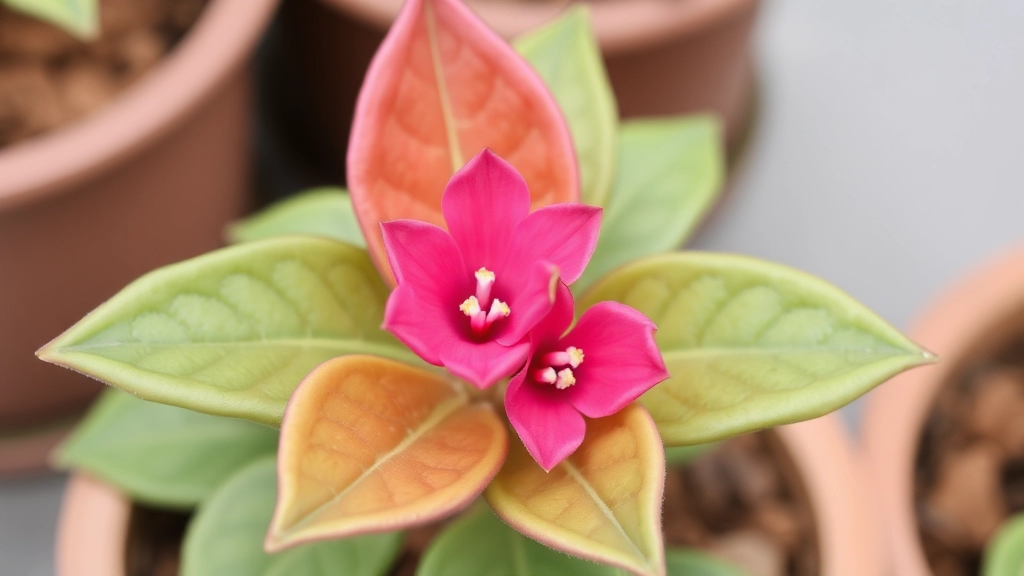Curious about the Kalanchoe Beharensis Roseleaf?
This unique succulent, often admired for its fuzzy, silver-green leaves and distinctive shape, is a favourite among plant enthusiasts. Known for its resilience and low-maintenance nature, the Roseleaf variety stands out not just for its beauty but also for its ease of care, making it a perfect addition to any indoor garden.
Growing Kalanchoe Beharensis Roseleaf
When it comes to growing Kalanchoe Beharensis Roseleaf, ensuring the right environment is key. This plant thrives in bright, indirect sunlight and well-draining soil. Overwatering is a common pitfall, so it’s essential to let the soil dry out between waterings. With the right conditions, your Roseleaf will flourish, adding a touch of exotic charm to your space.
Distinctive Features of Kalanchoe Beharensis ‘Roseleaf’
When considering the Kalanchoe Beharensis ‘Roseleaf’, one might wonder what sets this stunning succulent apart from its relatives.
Unique Leaf Structure
The ‘Roseleaf’ variety boasts striking, fleshy leaves that are uniquely shaped like a rose. Their soft, velvety texture and silvery-green hue create a captivating visual appeal.
- Size: Leaves can grow up to 10 cm long.
- Shape: Distinctive, rounded edges that mimic rose petals.
- Color: A beautiful blend of green with subtle hints of purple along the edges.
Growth Habit
This plant typically develops a bushy appearance, making it an excellent choice for both indoor and outdoor settings.
- Height: Can reach heights of up to 60 cm.
- Branching: Grows multiple stems, creating a fuller look.
Flowering Characteristics
While the primary attraction is its foliage, Kalanchoe ‘Roseleaf’ can produce small, tubular flowers.
Ideal Growing Conditions for Kalanchoe Beharensis ‘Roseleaf’
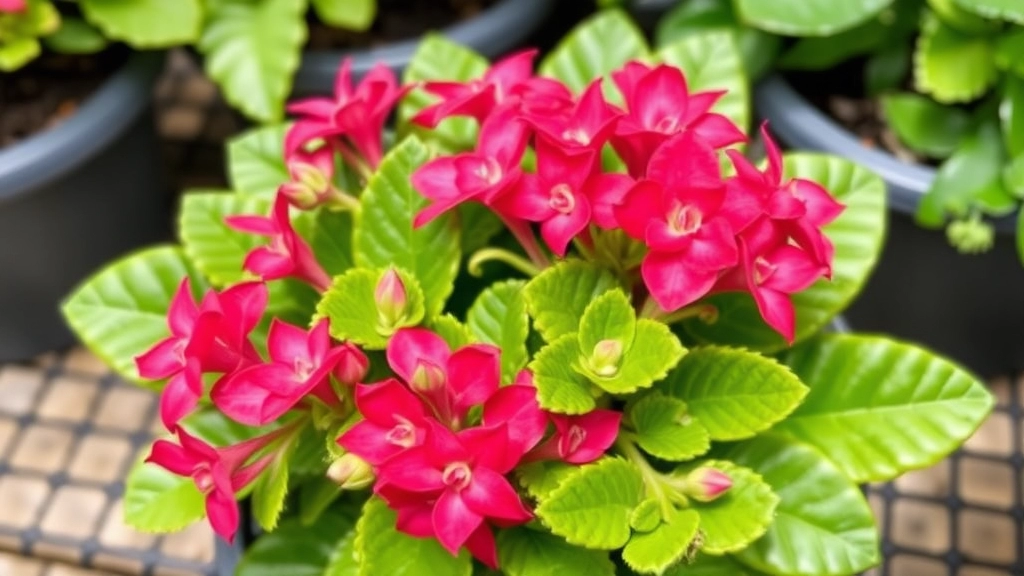
So, you’ve got your eye on the stunning Kalanchoe Beharensis ‘Roseleaf’ and are wondering what it needs to thrive?
Let’s dive into the ideal growing conditions for this fabulous plant.
Temperature
- Warmth is Key: ‘Roseleaf’ loves warmth. Aim for temperatures between 20°C and 25°C (68°F – 77°F) during the day.
- Cool Nights: It can tolerate cooler nights down to 10°C (50°F), but don’t let it freeze!
Humidity
- Low Humidity: This plant prefers drier air. Keep humidity levels low to moderate; around 30-50% is perfect.
- Air Circulation: Ensure good air circulation to prevent any dampness that could lead to rot.
Location
- Bright Spot: Place your ‘Roseleaf’ in a bright spot, ideally near a south or west-facing window.
- Avoid Direct Sun: It can handle some direct sunlight, but too much can scorch those beautiful leaves.
Potting and Drainage
- Well-Draining Pot: Use a pot with drainage holes to avoid waterlogging.
- Soil Choice: A cactus or succulent mix works wonders, allowing for proper drainage and aeration.
Seasonal Changes
- Adapt to Seasons: In winter, it may need a bit more light, so consider moving it closer to a window.
Watering and Soil Needs for Optimal Growth
When it comes to caring for Kalanchoe Beharensis ‘Roseleaf’, understanding its watering and soil requirements is essential for ensuring vibrant growth. Many plant enthusiasts often wonder how to strike the right balance, as overwatering can be detrimental.
Watering Guidelines
Kalanchoe ‘Roseleaf’ thrives in a specific watering routine. Here are some key points to consider:
- Frequency: Water your plant every 2-3 weeks, allowing the soil to dry out completely between waterings.
- Method: Use the soak-and-dry method. Water thoroughly until it drains out of the bottom, then let it dry completely.
- Signs of Overwatering: Yellowing leaves or a mushy stem can indicate too much water. Adjust your schedule accordingly.
Soil Requirements
The right soil mix is crucial for optimal growth. Here’s what you should look for:
- Type: A well-draining cactus or succulent mix is ideal. This prevents excess moisture from sitting around the roots.
- pH Level: Aim for a slightly acidic to neutral pH (around 6.0 to 7.0).
- Additives: Consider adding perlite or sand to improve drainage and aeration. For more detailed guidance, you can refer to our expert tips for healthy growth.
If you’re interested in expanding your Kalanchoe collection, don’t miss our guide to buying Kalanchoe Tomentosa online for the best deals and quality plants.
How to Provide Proper Sunlight for Kalanchoe ‘Roseleaf’
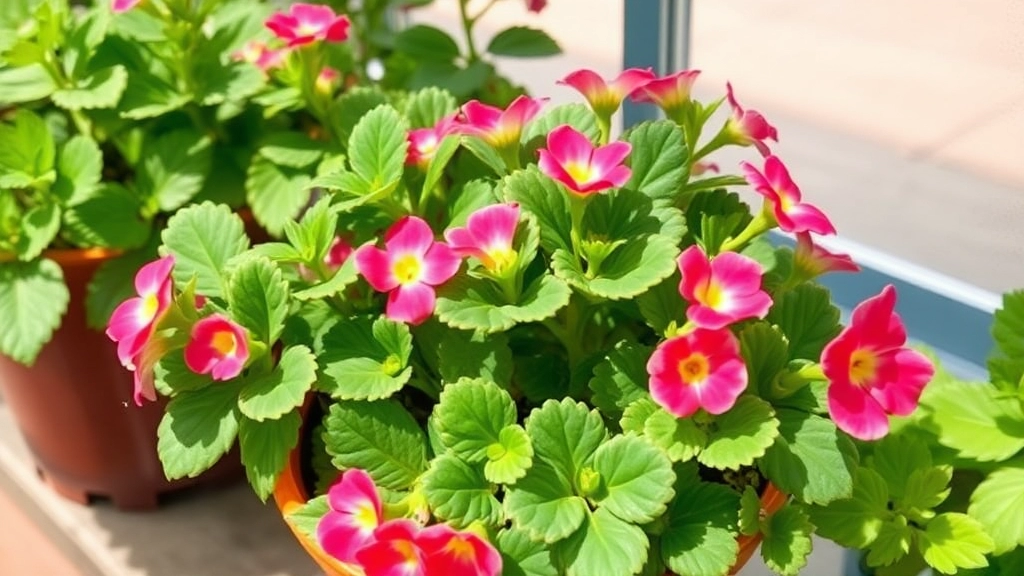
One of the key aspects of nurturing your Kalanchoe Beharensis ‘Roseleaf’ is ensuring it receives the right amount of sunlight. Without adequate light, this stunning succulent may struggle to thrive, leaving you wondering what went wrong.
Understanding Light Requirements
Kalanchoe ‘Roseleaf’ thrives in bright, indirect sunlight. Here’s how to ensure it gets the light it needs:
- Location: Place your plant near a window that receives filtered sunlight. South or west-facing windows are ideal.
- Duration: Aim for 6 to 8 hours of light daily. Too little light can lead to leggy growth, while too much direct sunlight can scorch the leaves.
- Seasonal Adjustments: During winter, you might need to move your plant closer to the window as daylight hours decrease.
Signs of Insufficient or Excessive Light
To ensure your Kalanchoe ‘Roseleaf’ is happy, keep an eye out for these signs:
- Insufficient Light: Leaves may become elongated and pale.
- Excessive Light: Leaves may turn brown or develop sunburn spots.
Tips for Optimising Sunlight Exposure
- Rotate Your Plant: Every few weeks, rotate your Kalanchoe to ensure all sides receive equal light.
- Use Sheer Curtains: If your plant is near a bright window, sheer curtains can help diffuse harsh sunlight while still providing adequate brightness.
- Consider Artificial Light: If natural light is limited, consider using grow lights to supplement.
Propagation Techniques for Kalanchoe Beharensis ‘Roseleaf’
Are you looking to expand your collection of Kalanchoe Beharensis ‘Roseleaf’? Propagation can be both rewarding and straightforward, allowing you to share this stunning plant with friends or fill your own space with greenery. Here are some effective methods to propagate ‘Roseleaf’.
Leaf Cuttings
One of the simplest ways to propagate ‘Roseleaf’ is through leaf cuttings. Here’s how you can do it:
- Select a Healthy Leaf: Choose a mature, healthy leaf from the parent plant.
- Cut the Leaf: Use a clean, sharp knife to cut the leaf at the base.
- Let it Callus: Place the leaf in a dry, shaded area for a few days until the cut end forms a callus.
- Plant the Leaf: Once calloused, place the leaf in well-draining soil, ensuring the cut end is buried slightly.
- Water Sparingly: Mist the soil lightly, keeping it moist but not soggy.
Offsets
Kalanchoe ‘Roseleaf’ can also produce offsets, or small plants that grow from the base of the parent. Here’s how to handle them:
- Identify Offsets: Look for small rosettes emerging from the base.
- Remove Carefully: Gently twist or cut the offset away from the parent plant.
- Replant: Place the offset in its own pot with well-draining soil.
- Water Lightly: Give it a little water and place it in indirect sunlight.
Seed Propagation
Although less common, you can also propagate ‘Roseleaf’ from seeds. This method requires patience but can be fulfilling:
Differences Between ‘Roseleaf’ and Other Kalanchoe Varieties
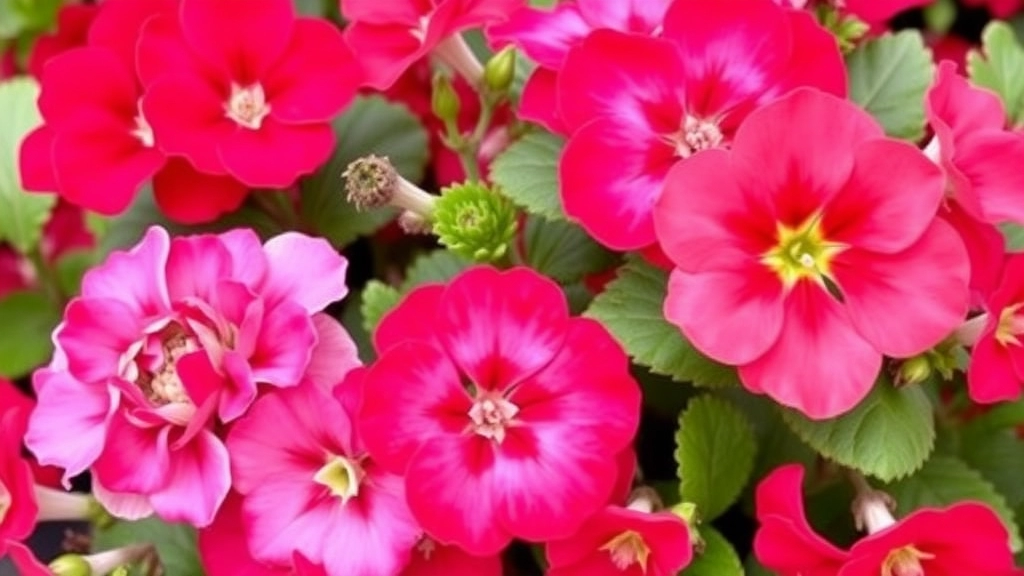
When diving into the world of Kalanchoe, it’s easy to get lost among the many varieties. So, what makes Kalanchoe Beharensis ‘Roseleaf’ stand out from the crowd?
First off, let’s talk about its unique leaves.
- Leaf Shape and Texture:
- ‘Roseleaf’ boasts large, rounded leaves with a striking rose-like shape.
- Other Kalanchoe varieties, like Kalanchoe Blossfeldiana, typically have smaller, more traditional succulent leaves.
- Colouration:
- The leaves of ‘Roseleaf’ are often a beautiful grey-green, sometimes tinged with a hint of pink.
- In contrast, many other varieties have a more uniform green or vibrant hues, like the bright reds and yellows of Kalanchoe ‘Flapjack’.
- Growth Habit:
- ‘Roseleaf’ tends to grow upright, creating a striking silhouette.
- Other types, such as Kalanchoe Tomentosa (Panda Plant), have a more sprawling growth pattern.
- Flowering:
- While ‘Roseleaf’ is primarily grown for its foliage, it does produce small flowers, though not as prominently as other varieties that are known for their vibrant blooms, like Kalanchoe ‘Pink Butterfly’.
So, if you’re looking for a Kalanchoe that adds a unique touch to your collection with its stunning foliage rather than its flowers, ‘Roseleaf’ is your go-to.
As you nurture your Kalanchoe Beharensis ‘Roseleaf’, it’s essential to stay vigilant against common pests and diseases that can compromise its health.
### Common Pests
– **Mealybugs**
These pests appear as small, white, cotton-like clusters on the leaves and stems. They can cause leaf yellowing and stunted growth.
**Control:** Use a cotton swab dipped in rubbing alcohol to remove them. In severe cases, insecticidal soap may be necessary.
– **Spider Mites**
Tiny and often invisible to the naked eye, spider mites thrive in dry conditions. They can create fine webbing and lead to leaf discolouration.
**Control:** Increase humidity around the plant and wash the leaves regularly to dislodge them.
– **Aphids**
These small, green insects cluster on new growth and can cause distortion of leaves.
**Control:** A strong spray of water can knock them off, or use insecticidal soap for a more persistent approach.
### Common Diseases
– **Root Rot**
Often caused by overwatering, root rot leads to wilting and yellowing leaves.
**Control:** Ensure proper drainage and allow the soil to dry out between waterings.
– **Powdery Mildew**
This fungal infection appears as a white powdery coating on leaves.
**Control:** Improve air circulation and avoid overhead watering. Fungicides may also help.
– **Leaf Spot**
Characterized by dark spots on leaves, this can be caused by fungal infections or bacterial issues.
**Control:** Remove affected leaves and ensure good airflow around the plant.
For more detailed care tips, you can refer to the [care tips for Kalanchoe Beharensis](https://planthq.org/care-tips-for-kalanchoe-beharensis-cv-fang-succulent/) or learn about the [propagation of Kalanchoe Beharensis](https://planthq.org/care-and-propagation-of-kalanchoe-beharensis-tree/).
Seasonal Care Tips for Indoor and Outdoor Growth of Kalanchoe Beharensis ‘Roseleaf’

So, you’ve got your Kalanchoe Beharensis ‘Roseleaf’ and you’re ready to nurture it through the seasons. But how do you adapt your care routine as the weather changes? Let’s break it down.
Spring: Awakening Growth
As spring rolls in, your ‘Roseleaf’ will start to perk up after the winter slump.
- Light: Increase sunlight exposure gradually. A south-facing window is ideal.
- Watering: Start watering more frequently, but ensure the soil dries out between sessions.
- Fertilizing: Begin feeding with a balanced, diluted fertiliser every 4-6 weeks.
Summer: Thriving Heat
Summer is when your Kalanchoe really shines, but it needs some extra TLC.
- Watering: Keep the soil moist but not soggy. Water deeply, then let it dry.
- Humidity: If indoors, consider a humidity tray to keep things comfortable.
- Pest Watch: Be on the lookout for pests like mealybugs. A quick inspection can save you a headache later.
Autumn: Preparing for Rest
As the days get shorter, your plant will start to slow down.
- Light: Reduce direct sunlight to prevent leaf scorch.
- Watering: Cut back on watering. Let the soil dry out more between drinks.
- Fertilizing: Stop fertilising as the plant prepares for dormancy.
Winter: Dormancy Mode
Winter can be tough, but your ‘Roseleaf’ is resilient.
- Temperature: Keep it in a warm spot, ideally above 10°C.
- Watering: Only water when the soil is completely dry. Less is more!
- Light: Ensure it still gets some indirect sunlight to keep it healthy.
Tips for Repotting and Maintaining Healthy Growth
Repotting your Kalanchoe Beharensis ‘Roseleaf’ can seem daunting, but it’s essential for ensuring your plant thrives. You may wonder when and how to repot effectively to support its growth.
When to Repot
- Signs Your Plant Needs Repotting:
- Roots are growing out of the drainage holes.
- Soil dries out too quickly.
- The plant appears top-heavy or is leaning.
Choosing the Right Pot
- Pot Size:
- Select a pot that is 1-2 inches larger in diameter than the current one.
- Material:
- Terracotta or ceramic pots are ideal as they allow for better airflow.
Soil Selection
- Best Soil Mix:
- Use a well-draining cactus or succulent mix.
- You can also create your own by mixing potting soil with sand or perlite.
Repotting Steps
- Prepare Your Workspace:
- Gather your new pot, soil, and tools like a trowel and gloves.
- Gently take the ‘Roseleaf’ out of its current pot.
- Be careful not to damage the roots.
- Trim any dead or rotten roots with sterilised scissors.
- Place a layer of fresh soil at the bottom of the new pot.
- Set the plant in the centre and fill in with soil, ensuring the root ball is level with the rim.
- Water the plant sparingly after repotting to avoid root rot.
Maintenance Tips for Healthy Growth
- Light Requirements:
- Ensure your ‘Roseleaf’ gets plenty of bright, indirect sunlight.
- Watering Schedule:
- Allow the soil to dry out completely between waterings.
- Fertilisation:
- Feed with a diluted succulent fertiliser during the growing season.
Repotting not only provides your Kalanchoe ‘Roseleaf’ with fresh nutrients but also gives you a chance to check its overall health. For more detailed care tips, check out our Kalanchoe Beharensis Fang care guide and our guide on care and propagation of Kalanchoe Beharensis.
Best Practices for Fertilizing Kalanchoe ‘Roseleaf’
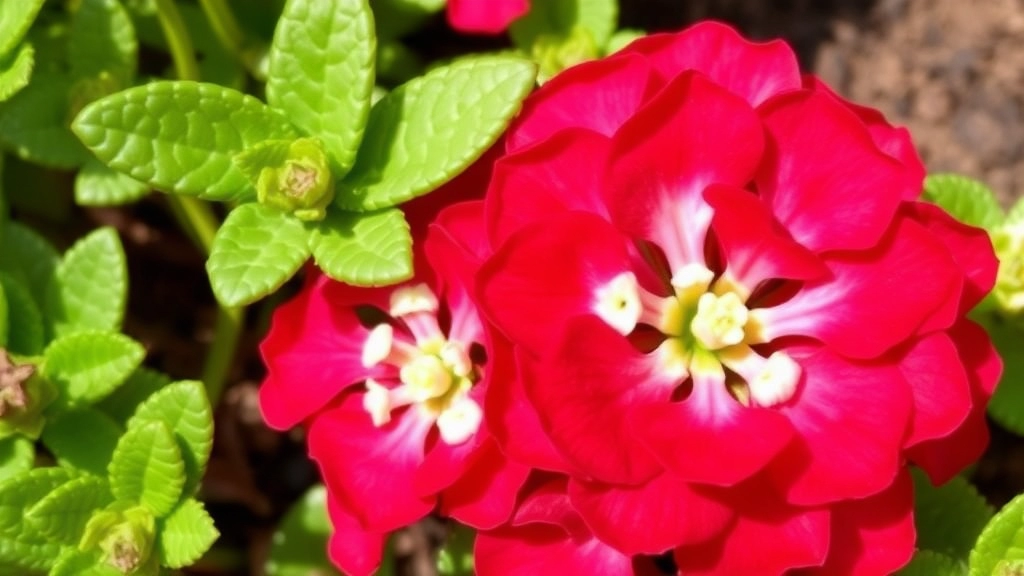
So, you’re keen to give your Kalanchoe Beharensis ‘Roseleaf’ the best shot at thriving?
Fertilizing is a key part of that journey.
When to Fertilize
- Growing Season: The best time to fertilize is during the growing season, which typically runs from spring to early autumn.
- Frequency: Aim to fertilize every 4-6 weeks. This keeps your plant nourished without overwhelming it.
What Type of Fertilizer?
- Balanced Fertilizer: Use a balanced, water-soluble fertilizer, ideally one with a ratio like 10-10-10 or 20-20-20.
- Dilution: Always dilute it to half the recommended strength. Kalanchoes are not heavy feeders, so less is more!
Application Tips
- Water First: Water your plant a day before applying fertilizer. This helps prevent root burn.
- Even Distribution: Pour the diluted fertilizer evenly around the base of the plant. Avoid getting it on the leaves, as this can lead to burns.
Signs Your Plant Needs Fertilizer
- Pale Leaves: If the leaves start looking pale, it might be time for a boost.
- Stunted Growth: If your ‘Roseleaf’ seems to be growing slower than usual, a little fertilizer could help.
Post-Fertilization Care
- Watering: After fertilizing, continue with your regular watering schedule. This helps to wash away any excess fertilizer and keeps the roots happy.
Toxicity Concerns and Pet Safety Considerations
As we delve into the care of Kalanchoe Beharensis ‘Roseleaf’, it’s crucial to address a significant concern for many plant enthusiasts: toxicity.
Understanding Toxicity
Kalanchoe ‘Roseleaf’ is known to be toxic to pets, particularly cats and dogs. The plant contains compounds called bufadienolides, which can lead to various health issues if ingested.
Symptoms of Poisoning
If your pet nibbles on this succulent, watch for these symptoms:
- Vomiting
- Diarrhoea
- Lethargy
- Tremors
- Changes in heart rate
If you observe any of these signs, it’s essential to consult a veterinarian immediately.
Preventive Measures
To safeguard your furry friends, consider these strategies:
- Placement: Keep Kalanchoe ‘Roseleaf’ out of reach. High shelves or hanging pots can help.
- Education: Teach your pets which plants are off-limits. Though they may not understand, consistent training can deter them.
- Alternatives: Opt for pet-safe plants if your household has curious animals. For more information on how to care for Kalanchoe Beharensis, check out this care guide.
If you are interested in other varieties, you might find the Kalanchoe Tomentosa varieties particularly intriguing.
FAQs on Kalanchoe Beharensis ‘Roseleaf’
What are the ideal growing conditions for Kalanchoe Beharensis ‘Roseleaf’?
Kalanchoe Beharensis ‘Roseleaf’ thrives in warm temperatures between 20°C and 25°C (68°F – 77°F) during the day and can tolerate cooler nights down to 10°C (50°F). It prefers low to moderate humidity levels (30-50%) and should be placed in a bright spot with indirect sunlight, ideally near a south or west-facing window. Use a well-draining pot and soil mix designed for cacti or succulents.
How much sunlight does Kalanchoe ‘Roseleaf’ need?
Your Kalanchoe ‘Roseleaf’ needs bright, indirect sunlight for about 6 to 8 hours daily. Too little light can cause leggy growth, while too much direct sunlight can scorch the leaves. Consider using sheer curtains to diffuse harsh sunlight or supplementing with grow lights if natural light is limited.
What makes Kalanchoe Beharensis ‘Roseleaf’ different from other Kalanchoe varieties?
‘Roseleaf’ has large, rounded, rose-like leaves that are often grey-green with hints of pink. It grows upright, unlike other varieties that may have more sprawling growth patterns. While it does produce small flowers, it is primarily grown for its unique foliage rather than its blooms.
How should I care for my Kalanchoe ‘Roseleaf’ during different seasons?
Spring: Increase sunlight exposure gradually, water more frequently, and start fertilizing every 4-6 weeks.
Summer: Keep the soil moist but not soggy, consider a humidity tray if indoors, and watch for pests.
Autumn: Reduce direct sunlight, cut back on watering, and stop fertilizing.
Winter: Keep in a warm spot above 10°C, water only when the soil is completely dry, and ensure it gets some indirect sunlight.
When and how should I fertilize my Kalanchoe ‘Roseleaf’?
Fertilize during the growing season (spring to early autumn) every 4-6 weeks using a balanced, water-soluble fertilizer diluted to half strength. Water your plant a day before applying the fertilizer and distribute it evenly around the base, avoiding the leaves to prevent burns.
What are the signs that my Kalanchoe ‘Roseleaf’ needs fertilizer?
Look for pale leaves or stunted growth as indicators that your plant may need a nutrient boost. After fertilizing, continue with your regular watering schedule to wash away any excess fertilizer and keep the roots healthy.
Can I grow Kalanchoe ‘Roseleaf’ both indoors and outdoors?
Yes, Kalanchoe ‘Roseleaf’ can be grown both indoors and outdoors. Just ensure it gets the right amount of light, and adjust your care routine according to the season. For indoor growth, consider humidity levels and air circulation, while for outdoor growth, protect it from extreme weather conditions.
References
-
Kalanchoe Plant Care: Learn How To Grow Kalanchoe Plants
-
How to Grow Kalanchoe Succulents
-
Kalanchoe Beharensis – House Plants Expert
